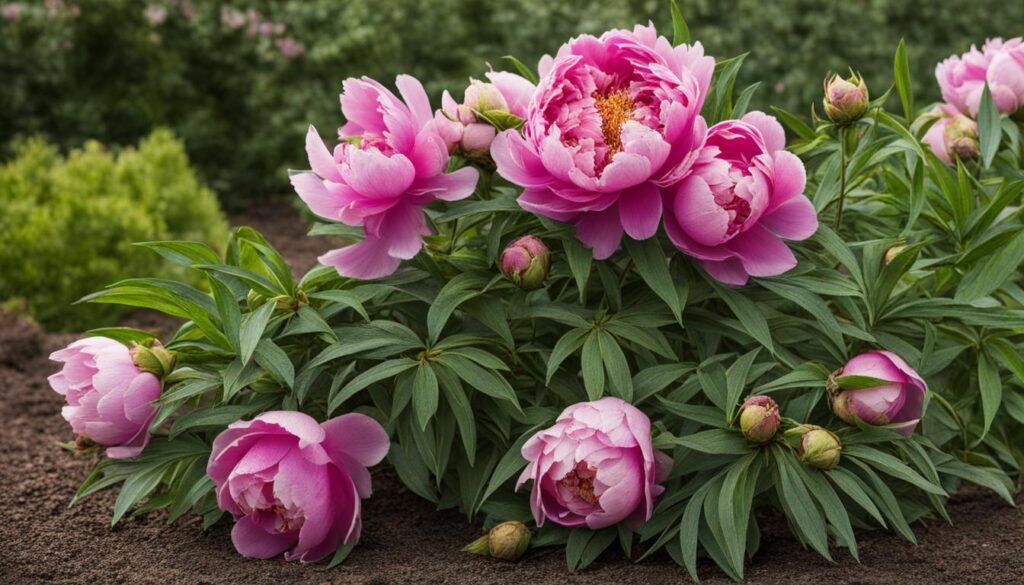Knowing when to prune your peonies is crucial for promoting vibrant growth and ensuring a bountiful display of blooms. Properly caring for your peonies will help them thrive throughout the peony season, which typically occurs between April and June.
By understanding the different stages of blooming, you can determine the ideal time to cut back your peonies. Pruning at the right time will encourage healthy plants and abundant blooming for the following year.
Whether you’re an experienced gardener or new to peony care, this article will provide valuable insights on when and how to cut back your peonies, ensuring they stay healthy and beautiful bloom after bloom.
When To Deadhead Peonies
After peonies have finished blooming, it’s time to deadhead the faded flowers. Deadheading not only improves the overall aesthetic of your peony plants but also helps redirect their energy towards next year’s growth and blooms. While deadheading doesn’t promote the production of more flowers like in some other plants, it allows the peony to conserve its energy and focus on developing strong foliage and new blooms for the following season.
Deadheading your peonies is best done once the flowers have passed their prime. As soon as you notice the petals starting to fade and wilt, it’s time to remove the spent flowers. Gently grip the stem below the fading flower and carefully snap it off, making sure not to damage the emerging buds or nearby foliage. By removing the old blooms, you’re giving your peony plants the opportunity to redirect their energy towards future growth and the development of healthy new flowers.
Performing the deadheading task also presents an excellent opportunity to fertilize your peonies and provide them with the necessary nutrients for healthy growth. After removing the faded flowers, apply a balanced fertilizer around the base of the plant according to the manufacturer’s instructions. This will help replenish the soil with essential nutrients and ensure your peonies have the fuel they need to flourish.
Remember, deadheading peonies and fertilizing them go hand in hand. By removing the spent flowers and providing proper nourishment, you’re setting the stage for a robust and beautiful display of flowers in the coming season.
When To Cut Back Peony Foliage
Pruning peony foliage requires careful timing to maintain plant health and prevent the spread of diseases. While it may be tempting to cut back the leaves throughout the season, it’s important to wait until fall to prune them. Removing the foliage too early can negatively impact next year’s flowers.
Peony foliage is susceptible to fungal diseases such as powdery mildew, which can affect the plant’s appearance but won’t kill it. To promote healthy foliage, it’s crucial to provide the peony with full sun and proper air circulation.
Pruning the foliage in the fall, after a hard frost, helps maintain the plant’s shape and reduces the risk of disease.
Remember that it’s essential to follow the correct timing for pruning and care for your peony leaves to ensure their optimal growth and beautiful blooms.
Why It’s Important to Cut Back Peony Plants
When it comes to maintaining the health and vitality of your peony plants, cutting them back is a crucial step. Not only does pruning help prevent pests and diseases from harming the plant, but it also plays a significant role in overall garden cleanup. By removing plant debris, including fallen leaves and stems, you eliminate potential hiding spots for pests and minimize the risk of diseases taking hold.
If you’ve experienced disease issues during the growing season, pruning becomes even more critical. By cutting back the affected areas, you can remove diseased or damaged portions, allowing the plant to focus its energy on healthy growth. This helps maintain the overall health and vigor of your peonies.
During the winter months, when peony plants are dormant, adding a light layer of mulch around the base of the plant can provide additional protection. The winter mulch acts as insulation, shielding the plant from extreme temperature fluctuations. However, remember to remove the mulch in the spring before new growth emerges to prevent any potential issues.
By following proper pruning practices and ensuring a clean garden environment, you can help your peonies thrive year after year. Removing plant debris, preventing pests and diseases, and providing winter protection with mulch are essential steps in maintaining the health and beauty of your peony plants.
What is the Best Time of Year to Cut Back and Transplant Peonies?
The best time to cut back and transplant peonies is in the fall. This is considered one of the best practices for transplanting peonies as it allows the plant to establish its roots before the winter season. It also gives the plant enough time to acclimate to its new location before the spring growth starts.










